 Primary
Age. (Up to 500 million years ago.) Mountains
thrown up. Erosion.
Primary
Age. (Up to 500 million years ago.) Mountains
thrown up. Erosion.
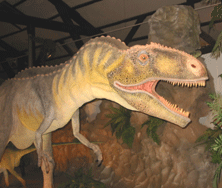
![]() Secondary
Age. (Up to 65 million years ago.) Erosion
continues. Dinosaurs roam the Languedoc. You can see their
fossilised bones and eggs for example at at Espéraza
the Aude.
Secondary
Age. (Up to 65 million years ago.) Erosion
continues. Dinosaurs roam the Languedoc. You can see their
fossilised bones and eggs for example at at Espéraza
the Aude.
Tertiary Age. (Up to 40 million years
ago.) when the the Pyrenees
( Pirenèus,
Pirenèus,
 Pirineus,
Pirineus,
 Pyrénées)
are created as a result of tectonic activity. The
Iberian Plate slews into the European Plate, causing the
Iberian Plate to be subducted under the European Plate.
Consequent volcanism which continues today.
Pyrénées)
are created as a result of tectonic activity. The
Iberian Plate slews into the European Plate, causing the
Iberian Plate to be subducted under the European Plate.
Consequent volcanism which continues today.
Quaternary Age. (Since 40 million years ago.) Glaciers carve out new valleys and circs (or cwms). In the most recent period within the last three million years ago, humans arrive in the Languedoc.
c 2.5 million years ago: Cut quartz from this period has been found at Etouaires, Puy-de-Dôme.
c 1.5 million years ago: Homo Erectus, "standing man", and other pre-sapiens from Africa colonise Europe in several waves. Homo Erectus can use fire. Remains from this period have been found in Montmaurin (between Toulouse and Tarbes)
c 1,000,000 years ago: The plains of what are now the Aude , Gard and Hérault départements are occupied.
650 000 years ago: Warm period. Homo Erectus in the Roussillon (modern Pyrénées-Orientales département), Arch-anthropiens (from the Greek for "old-man"). Evidence has been found showing that he lived in huts and used sophisticated stone tools.
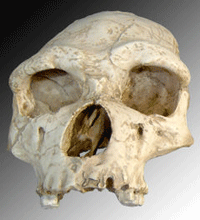
![]() 450
000 years ago: The warm period continues. Hippopotamus
in the Pyrenees mountains, also the machaïrode, the "sabre
toothed tiger"). Pithec-anthropes (from the Greek:
"monkey-man") arrive from Asia. Remains of Tautavel
Man discovered in the cave of la Caune de l'Arago in
the eastern Pyrenees). Warm period followed by
the Mindel glaciation. Fire was mastered at around this
time. Forges have been found at Lunel-Viel in the Hérault
département.
450
000 years ago: The warm period continues. Hippopotamus
in the Pyrenees mountains, also the machaïrode, the "sabre
toothed tiger"). Pithec-anthropes (from the Greek:
"monkey-man") arrive from Asia. Remains of Tautavel
Man discovered in the cave of la Caune de l'Arago in
the eastern Pyrenees). Warm period followed by
the Mindel glaciation. Fire was mastered at around this
time. Forges have been found at Lunel-Viel in the Hérault
département.
300 000 - 200,000 years ago: Riss glaciation ; Atlanthropes appear (from north Africa ?), leaving evidence of acheulean culture, with bi-face tools.
100 000 years ago: Arrival of the Pre-Sapiens at the Eyzies of Tayac and at the Moustier (Dordogne). Acheulean tools (pebbles worked on the 2 faces) dating from this period have been found at La Micoque (Dordogne) and in the Garonne valley. Tools used to make other tools, again from this period, have been found at Tayac (Dordogne). Both technologies were used between 90,000 and 35,000 years ago to make spikes, blades and scrapers. Examples have been found at the Moustier in the Dordogne. Also about 100 000 years ago, Neanderthal man appears. Given the name Homo sapiens, the "wise man", he is able to fashion tools, and to make his own clothes. He also buries his dead.
80,000 years ago: Würm glaciation starts. Neanderthal man is living at Hortus (Hérault) and at La Chapelle aux Saints (in Lozère).
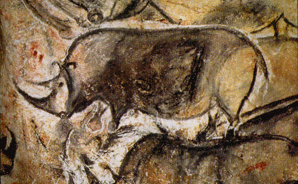
![]() 30,000
years ago: Cro-Magnon man is known, using a range of
flint and bone tools. Evidence has been found at the Grotte
de la Saltpétrière (near Remoulins, Gard),
Grotte de la Balauziere (near Vers, Gard),
Grotte Chabot (near Aiguèze, Gard),
Grotte de la Crouzade (Cesseras, le massif de La Clape,
Hérault).
The cave paintings at Chauvet-Pont-d'Arc in the Ardèche
to the north of the Languedoc date from this period (30,000
- 25,000 years ago). (This cave was discovered only on 18
December 1994)
30,000
years ago: Cro-Magnon man is known, using a range of
flint and bone tools. Evidence has been found at the Grotte
de la Saltpétrière (near Remoulins, Gard),
Grotte de la Balauziere (near Vers, Gard),
Grotte Chabot (near Aiguèze, Gard),
Grotte de la Crouzade (Cesseras, le massif de La Clape,
Hérault).
The cave paintings at Chauvet-Pont-d'Arc in the Ardèche
to the north of the Languedoc date from this period (30,000
- 25,000 years ago). (This cave was discovered only on 18
December 1994)
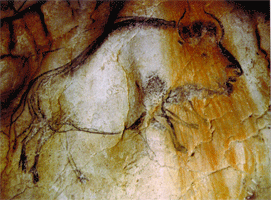 |
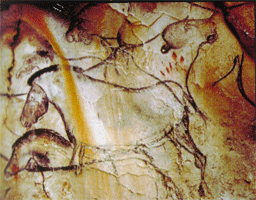 |
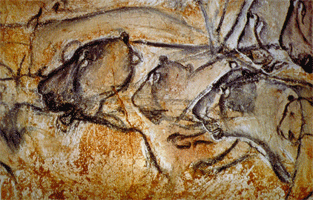
![]() Around
15,000 years ago: people were making long knives as
tools and hunting weapons. Examples are known from Saint-Quentin-la-Poterie
and in the Gard.
More cave paintings are known at the Grotte Bayol (near
Collias near the Pont
du Gard), the Grotte Chabot, and the Grotte de La Baume
Latrone (Gard), also various river canyons in the Ardeche.
Around
15,000 years ago: people were making long knives as
tools and hunting weapons. Examples are known from Saint-Quentin-la-Poterie
and in the Gard.
More cave paintings are known at the Grotte Bayol (near
Collias near the Pont
du Gard), the Grotte Chabot, and the Grotte de La Baume
Latrone (Gard), also various river canyons in the Ardeche.
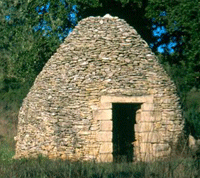
![]() The
Neolithic. Around 6,500 BC climatic warming corresponded
to the slow abandonment of the traditional hunter-gatherer
lifestyle and the adoption of a sedentary lifestyle along
with agriculture and the domestication of animals. Agriculturists
occupied the mountains and valleys while herders occupied
the plains and the areas of garrigue. The annual migration
of domesticated animals, notably cattle and sheep, known
as the transhumance, continues to this day (Shepherds belong
to the second oldest profession in the world). In the stone
age, Languedoc shepherds built round dry stone shelters
known as capitelles, which can still be seen in the
Aude, Gard, Hérault.
There is no roof. The stone walls simply converge to
form a vault.
The
Neolithic. Around 6,500 BC climatic warming corresponded
to the slow abandonment of the traditional hunter-gatherer
lifestyle and the adoption of a sedentary lifestyle along
with agriculture and the domestication of animals. Agriculturists
occupied the mountains and valleys while herders occupied
the plains and the areas of garrigue. The annual migration
of domesticated animals, notably cattle and sheep, known
as the transhumance, continues to this day (Shepherds belong
to the second oldest profession in the world). In the stone
age, Languedoc shepherds built round dry stone shelters
known as capitelles, which can still be seen in the
Aude, Gard, Hérault.
There is no roof. The stone walls simply converge to
form a vault.
A ceramic style known as cardium was developed, using a sea shell to imprint distinctive patterns on pottery. Examples have been found in the Grotte des Fées (Fairies' Cave) at Leucate.
The earliest megaliths in the Languedoc date from around 3500 BC. The Languedoc is one of the richest areas for megaliths in the world. There are more than eight hundred dolmens and menhirs. Trepanned human skulls have been found at the dolmen at Nojared, showing that surgery was practised at this time - apparently successfully since the sawn bone had knitted.
![]()
![]() Megaliths
in the Aude Départment: Spectacular menhirs
include those at Counozouls
(are 8, 90 metres ) and Morrel
das Fadas (5 metres high). Notable dolmens
include the Saint-Eugène
(little Hill of Fairies) and Saint-Eugène, two biggest dolmens
of the southern France (with lengths of between 15 and 25
metres).
Megaliths
in the Aude Départment: Spectacular menhirs
include those at Counozouls
(are 8, 90 metres ) and Morrel
das Fadas (5 metres high). Notable dolmens
include the Saint-Eugène
(little Hill of Fairies) and Saint-Eugène, two biggest dolmens
of the southern France (with lengths of between 15 and 25
metres).
Megaliths in the Herault Départment:. Well worth seeing are the Menhirs at Ginestous and the Coste Rouge.
![]()
![]() Megaliths
in the Pyrénées-Orientales Départment:.
Including Morrel
das Fadas
Megaliths
in the Pyrénées-Orientales Départment:.
Including Morrel
das Fadas
The Copper Age. Around 2,500 years BC the people of the Languedoc started to work copper which is abundant in the Massif Central and the The Corbières. They also panned for gold in Languedoc rivers. Villages appeared at this time, built in dry stone like the more ancient capitelles. A good example may be seen at Fontbouisse (near to Sommières in the Gard).
The Bronze Age. After 2000 BC The people of the Languedoc learned to make bronze, using local copper and imported tin from the aquitaine, from around the Mediterranean Sea and even from Cornwall. Distinctive artefacts from this period include new styles of pottery and anthropomorphic stelae, along with symbols such as crosses, solar discs and pentacles. More villages appeared, such as Saint-Martin-de-Londres and Cambous, both in the Hérault
The Iron Age. Around the eighth century BC two distinct populations occupied the Languedoc, identifiable by their funerary customs. Immigrant agriculturists lived on the Mediterranean plains and the valleys of the rivers Aude and Garonne. Semi nomadic peoples, possibly Celts, lived in the garigues of the interior, burning their dead in tumuli.
Some of the earliest fortified hilltop settlements in the Languedoc, known as oppida date from this period, including the the Oppidum at Enserune.





